Socio-Economic and Legal Framework: Netflix Industry Analysis Report
VerifiedAdded on 2022/09/01
|14
|4002
|27
Report
AI Summary
This report provides a comprehensive analysis of Netflix's socio-economic and legal framework, focusing on its operations within the media and video streaming industries. It begins with an executive summary and an introduction to Netflix's history, business model, and competitors. The literature review explores the knowledge economy's impact on Netflix, discussing drivers of economic change and its ability to leverage data. The report then delves into the impact of the legal framework and political factors, including availability, censorship, and restrictions. Economic factors, such as currency risks and competition, are also examined. Social and technological factors, including the sharing economy, are analyzed for their influence on Netflix's business. The report concludes with a discussion of the findings and provides recommendations based on the analysis of Netflix's global operations and market position. The report includes references to support the analysis.
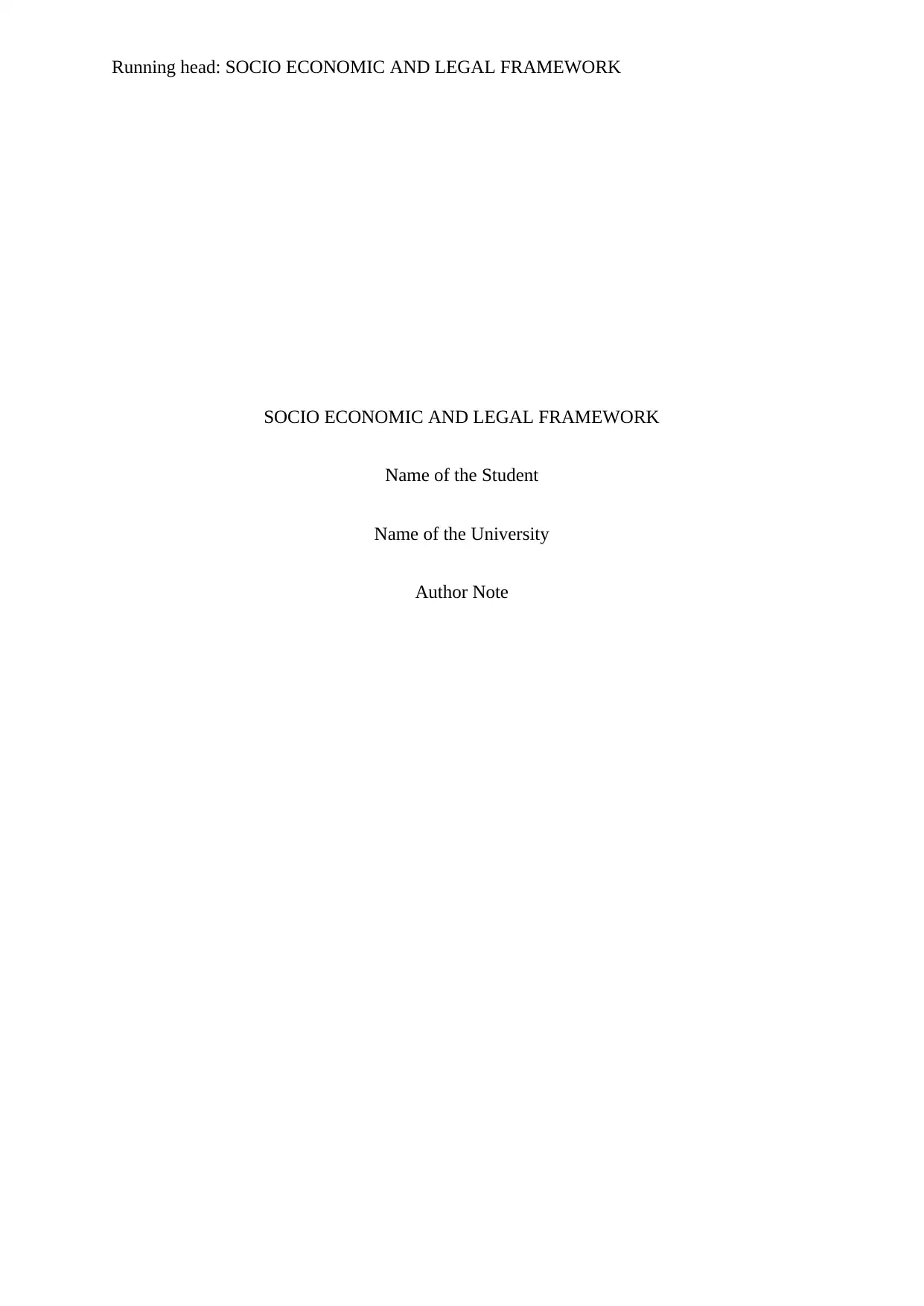
Running head: SOCIO ECONOMIC AND LEGAL FRAMEWORK
SOCIO ECONOMIC AND LEGAL FRAMEWORK
Name of the Student
Name of the University
Author Note
SOCIO ECONOMIC AND LEGAL FRAMEWORK
Name of the Student
Name of the University
Author Note
Paraphrase This Document
Need a fresh take? Get an instant paraphrase of this document with our AI Paraphraser
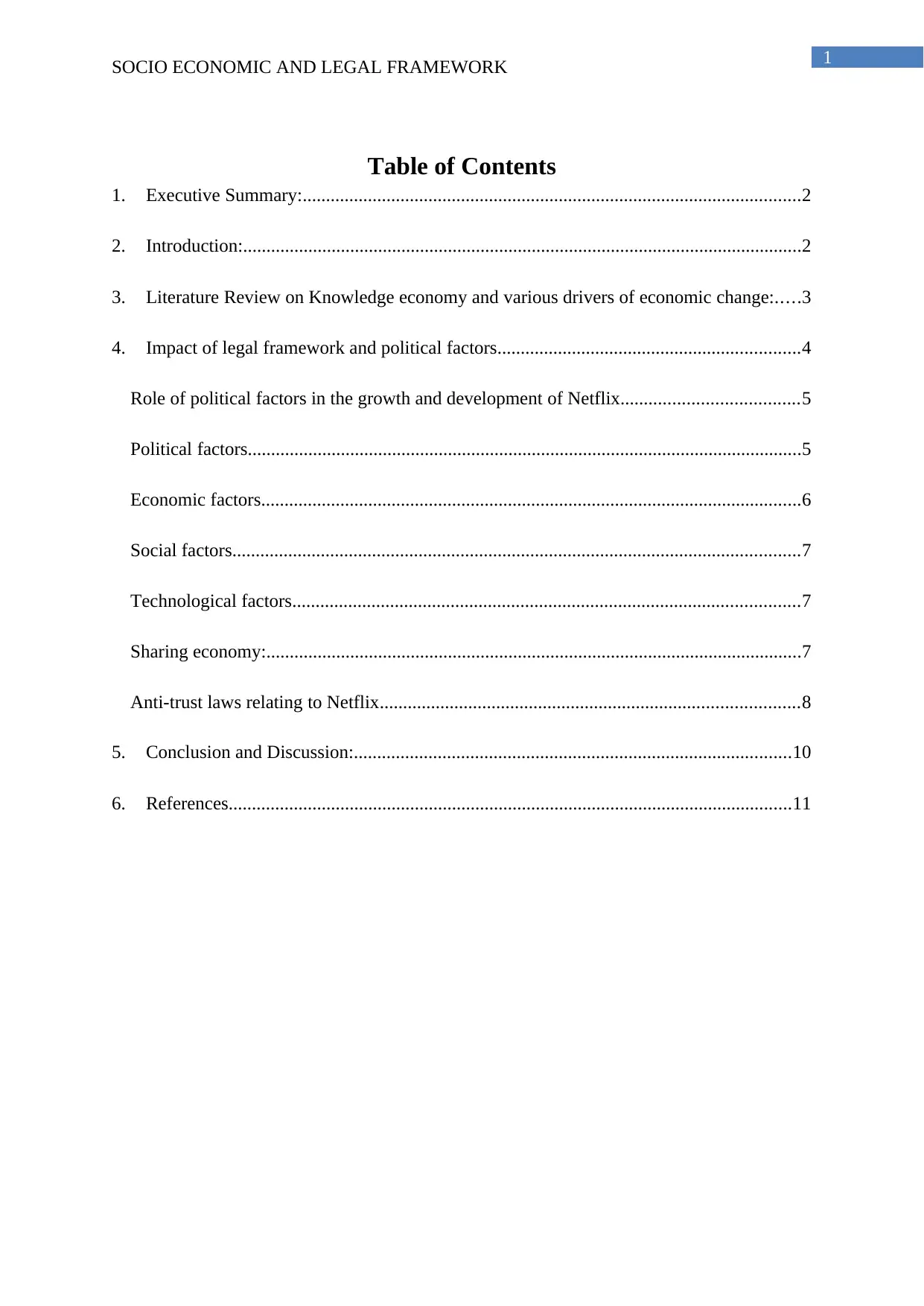
1
SOCIO ECONOMIC AND LEGAL FRAMEWORK
Table of Contents
1. Executive Summary:...........................................................................................................2
2. Introduction:........................................................................................................................2
3. Literature Review on Knowledge economy and various drivers of economic change:.....3
4. Impact of legal framework and political factors.................................................................4
Role of political factors in the growth and development of Netflix......................................5
Political factors.......................................................................................................................5
Economic factors....................................................................................................................6
Social factors..........................................................................................................................7
Technological factors.............................................................................................................7
Sharing economy:...................................................................................................................7
Anti-trust laws relating to Netflix..........................................................................................8
5. Conclusion and Discussion:..............................................................................................10
6. References.........................................................................................................................11
SOCIO ECONOMIC AND LEGAL FRAMEWORK
Table of Contents
1. Executive Summary:...........................................................................................................2
2. Introduction:........................................................................................................................2
3. Literature Review on Knowledge economy and various drivers of economic change:.....3
4. Impact of legal framework and political factors.................................................................4
Role of political factors in the growth and development of Netflix......................................5
Political factors.......................................................................................................................5
Economic factors....................................................................................................................6
Social factors..........................................................................................................................7
Technological factors.............................................................................................................7
Sharing economy:...................................................................................................................7
Anti-trust laws relating to Netflix..........................................................................................8
5. Conclusion and Discussion:..............................................................................................10
6. References.........................................................................................................................11
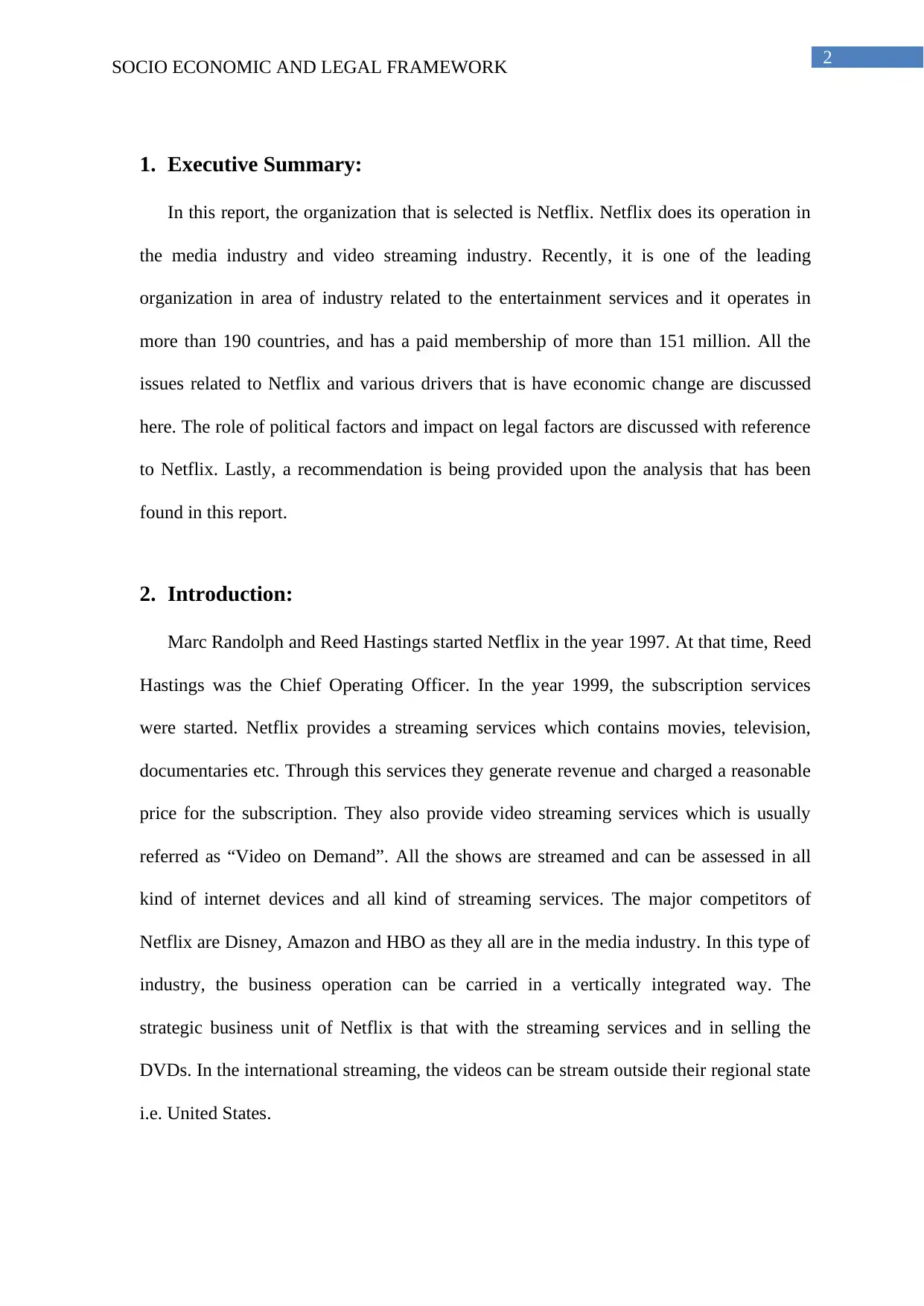
2
SOCIO ECONOMIC AND LEGAL FRAMEWORK
1. Executive Summary:
In this report, the organization that is selected is Netflix. Netflix does its operation in
the media industry and video streaming industry. Recently, it is one of the leading
organization in area of industry related to the entertainment services and it operates in
more than 190 countries, and has a paid membership of more than 151 million. All the
issues related to Netflix and various drivers that is have economic change are discussed
here. The role of political factors and impact on legal factors are discussed with reference
to Netflix. Lastly, a recommendation is being provided upon the analysis that has been
found in this report.
2. Introduction:
Marc Randolph and Reed Hastings started Netflix in the year 1997. At that time, Reed
Hastings was the Chief Operating Officer. In the year 1999, the subscription services
were started. Netflix provides a streaming services which contains movies, television,
documentaries etc. Through this services they generate revenue and charged a reasonable
price for the subscription. They also provide video streaming services which is usually
referred as “Video on Demand”. All the shows are streamed and can be assessed in all
kind of internet devices and all kind of streaming services. The major competitors of
Netflix are Disney, Amazon and HBO as they all are in the media industry. In this type of
industry, the business operation can be carried in a vertically integrated way. The
strategic business unit of Netflix is that with the streaming services and in selling the
DVDs. In the international streaming, the videos can be stream outside their regional state
i.e. United States.
SOCIO ECONOMIC AND LEGAL FRAMEWORK
1. Executive Summary:
In this report, the organization that is selected is Netflix. Netflix does its operation in
the media industry and video streaming industry. Recently, it is one of the leading
organization in area of industry related to the entertainment services and it operates in
more than 190 countries, and has a paid membership of more than 151 million. All the
issues related to Netflix and various drivers that is have economic change are discussed
here. The role of political factors and impact on legal factors are discussed with reference
to Netflix. Lastly, a recommendation is being provided upon the analysis that has been
found in this report.
2. Introduction:
Marc Randolph and Reed Hastings started Netflix in the year 1997. At that time, Reed
Hastings was the Chief Operating Officer. In the year 1999, the subscription services
were started. Netflix provides a streaming services which contains movies, television,
documentaries etc. Through this services they generate revenue and charged a reasonable
price for the subscription. They also provide video streaming services which is usually
referred as “Video on Demand”. All the shows are streamed and can be assessed in all
kind of internet devices and all kind of streaming services. The major competitors of
Netflix are Disney, Amazon and HBO as they all are in the media industry. In this type of
industry, the business operation can be carried in a vertically integrated way. The
strategic business unit of Netflix is that with the streaming services and in selling the
DVDs. In the international streaming, the videos can be stream outside their regional state
i.e. United States.
⊘ This is a preview!⊘
Do you want full access?
Subscribe today to unlock all pages.

Trusted by 1+ million students worldwide
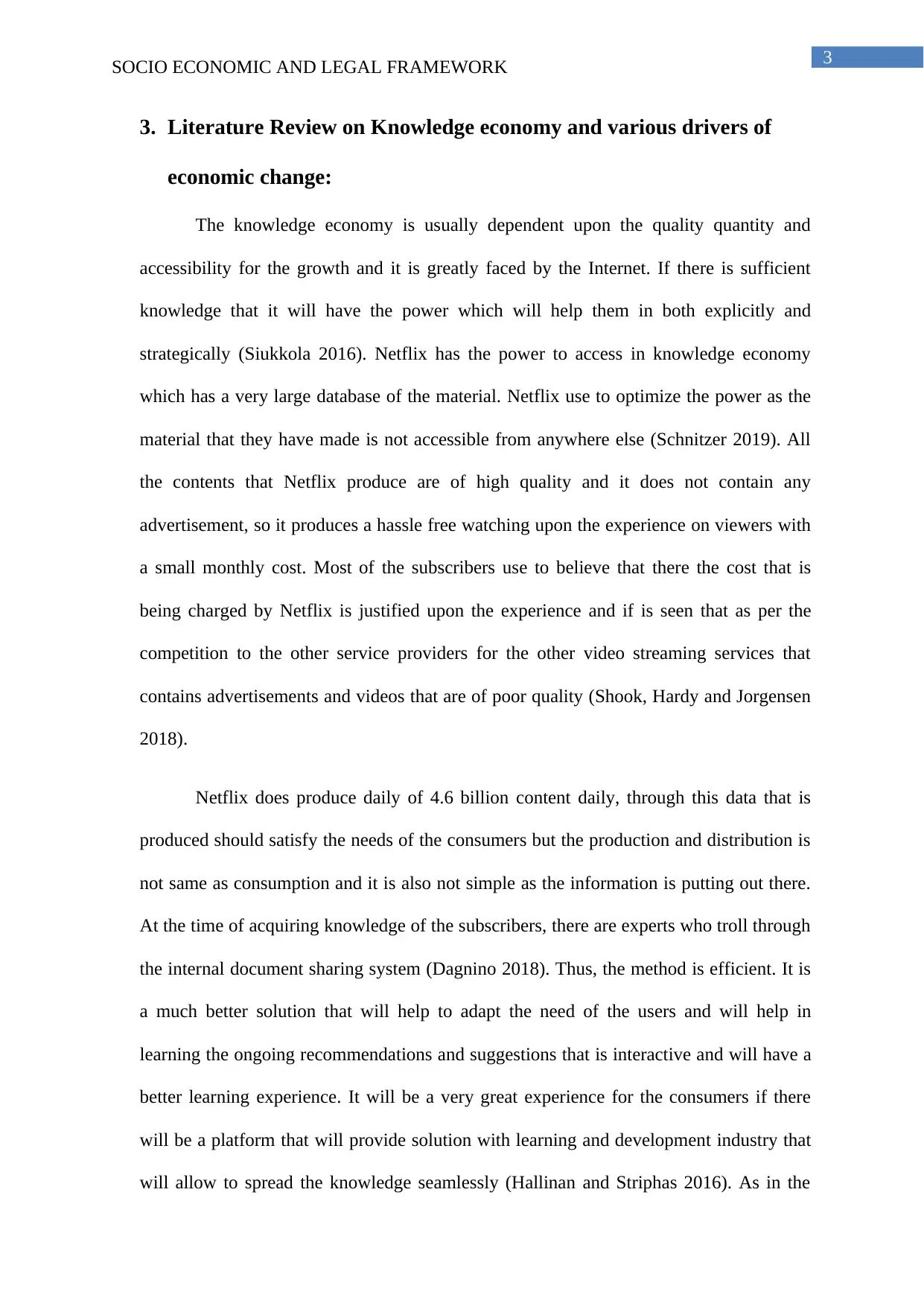
3
SOCIO ECONOMIC AND LEGAL FRAMEWORK
3. Literature Review on Knowledge economy and various drivers of
economic change:
The knowledge economy is usually dependent upon the quality quantity and
accessibility for the growth and it is greatly faced by the Internet. If there is sufficient
knowledge that it will have the power which will help them in both explicitly and
strategically (Siukkola 2016). Netflix has the power to access in knowledge economy
which has a very large database of the material. Netflix use to optimize the power as the
material that they have made is not accessible from anywhere else (Schnitzer 2019). All
the contents that Netflix produce are of high quality and it does not contain any
advertisement, so it produces a hassle free watching upon the experience on viewers with
a small monthly cost. Most of the subscribers use to believe that there the cost that is
being charged by Netflix is justified upon the experience and if is seen that as per the
competition to the other service providers for the other video streaming services that
contains advertisements and videos that are of poor quality (Shook, Hardy and Jorgensen
2018).
Netflix does produce daily of 4.6 billion content daily, through this data that is
produced should satisfy the needs of the consumers but the production and distribution is
not same as consumption and it is also not simple as the information is putting out there.
At the time of acquiring knowledge of the subscribers, there are experts who troll through
the internal document sharing system (Dagnino 2018). Thus, the method is efficient. It is
a much better solution that will help to adapt the need of the users and will help in
learning the ongoing recommendations and suggestions that is interactive and will have a
better learning experience. It will be a very great experience for the consumers if there
will be a platform that will provide solution with learning and development industry that
will allow to spread the knowledge seamlessly (Hallinan and Striphas 2016). As in the
SOCIO ECONOMIC AND LEGAL FRAMEWORK
3. Literature Review on Knowledge economy and various drivers of
economic change:
The knowledge economy is usually dependent upon the quality quantity and
accessibility for the growth and it is greatly faced by the Internet. If there is sufficient
knowledge that it will have the power which will help them in both explicitly and
strategically (Siukkola 2016). Netflix has the power to access in knowledge economy
which has a very large database of the material. Netflix use to optimize the power as the
material that they have made is not accessible from anywhere else (Schnitzer 2019). All
the contents that Netflix produce are of high quality and it does not contain any
advertisement, so it produces a hassle free watching upon the experience on viewers with
a small monthly cost. Most of the subscribers use to believe that there the cost that is
being charged by Netflix is justified upon the experience and if is seen that as per the
competition to the other service providers for the other video streaming services that
contains advertisements and videos that are of poor quality (Shook, Hardy and Jorgensen
2018).
Netflix does produce daily of 4.6 billion content daily, through this data that is
produced should satisfy the needs of the consumers but the production and distribution is
not same as consumption and it is also not simple as the information is putting out there.
At the time of acquiring knowledge of the subscribers, there are experts who troll through
the internal document sharing system (Dagnino 2018). Thus, the method is efficient. It is
a much better solution that will help to adapt the need of the users and will help in
learning the ongoing recommendations and suggestions that is interactive and will have a
better learning experience. It will be a very great experience for the consumers if there
will be a platform that will provide solution with learning and development industry that
will allow to spread the knowledge seamlessly (Hallinan and Striphas 2016). As in the
Paraphrase This Document
Need a fresh take? Get an instant paraphrase of this document with our AI Paraphraser
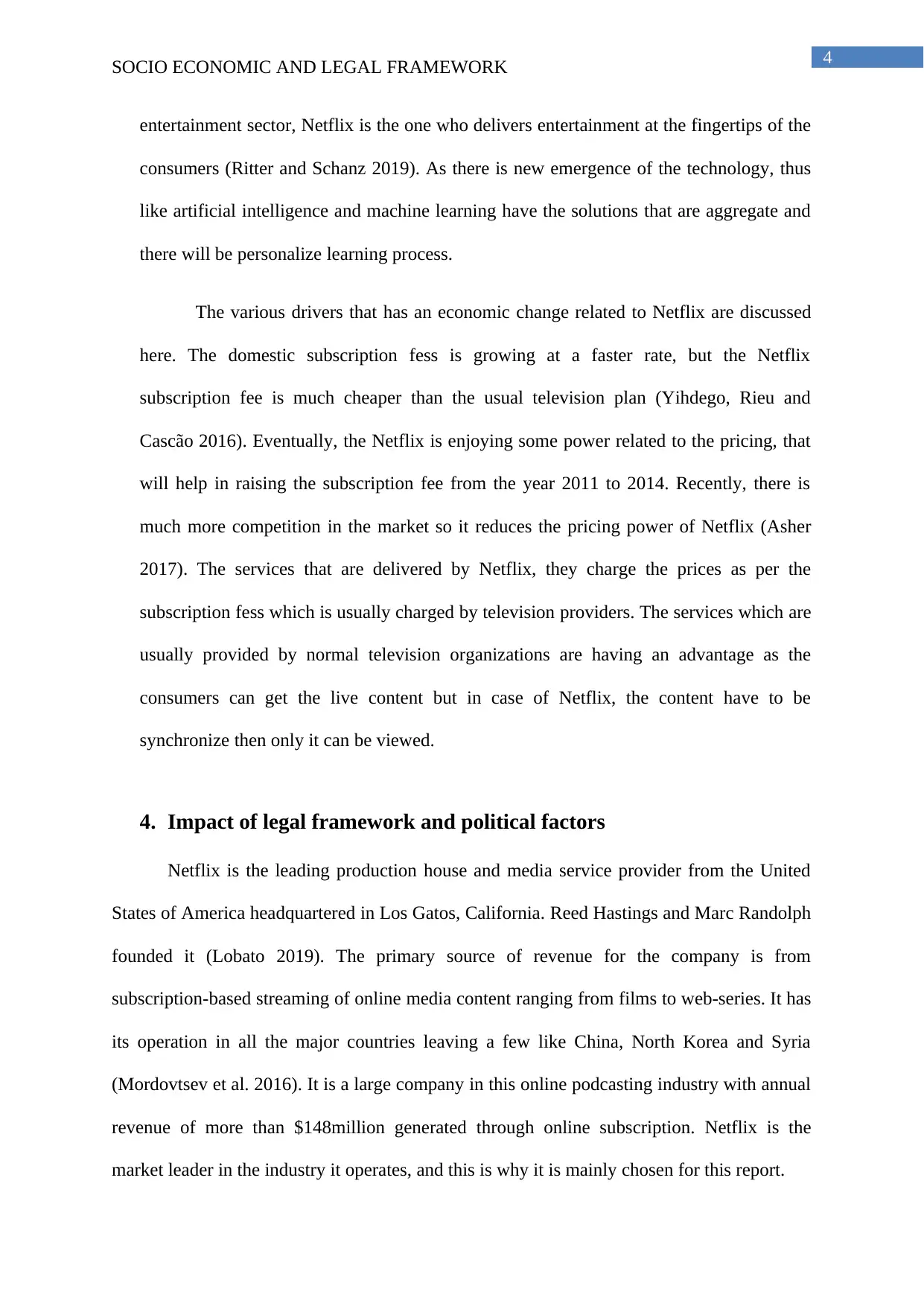
4
SOCIO ECONOMIC AND LEGAL FRAMEWORK
entertainment sector, Netflix is the one who delivers entertainment at the fingertips of the
consumers (Ritter and Schanz 2019). As there is new emergence of the technology, thus
like artificial intelligence and machine learning have the solutions that are aggregate and
there will be personalize learning process.
The various drivers that has an economic change related to Netflix are discussed
here. The domestic subscription fess is growing at a faster rate, but the Netflix
subscription fee is much cheaper than the usual television plan (Yihdego, Rieu and
Cascão 2016). Eventually, the Netflix is enjoying some power related to the pricing, that
will help in raising the subscription fee from the year 2011 to 2014. Recently, there is
much more competition in the market so it reduces the pricing power of Netflix (Asher
2017). The services that are delivered by Netflix, they charge the prices as per the
subscription fess which is usually charged by television providers. The services which are
usually provided by normal television organizations are having an advantage as the
consumers can get the live content but in case of Netflix, the content have to be
synchronize then only it can be viewed.
4. Impact of legal framework and political factors
Netflix is the leading production house and media service provider from the United
States of America headquartered in Los Gatos, California. Reed Hastings and Marc Randolph
founded it (Lobato 2019). The primary source of revenue for the company is from
subscription-based streaming of online media content ranging from films to web-series. It has
its operation in all the major countries leaving a few like China, North Korea and Syria
(Mordovtsev et al. 2016). It is a large company in this online podcasting industry with annual
revenue of more than $148million generated through online subscription. Netflix is the
market leader in the industry it operates, and this is why it is mainly chosen for this report.
SOCIO ECONOMIC AND LEGAL FRAMEWORK
entertainment sector, Netflix is the one who delivers entertainment at the fingertips of the
consumers (Ritter and Schanz 2019). As there is new emergence of the technology, thus
like artificial intelligence and machine learning have the solutions that are aggregate and
there will be personalize learning process.
The various drivers that has an economic change related to Netflix are discussed
here. The domestic subscription fess is growing at a faster rate, but the Netflix
subscription fee is much cheaper than the usual television plan (Yihdego, Rieu and
Cascão 2016). Eventually, the Netflix is enjoying some power related to the pricing, that
will help in raising the subscription fee from the year 2011 to 2014. Recently, there is
much more competition in the market so it reduces the pricing power of Netflix (Asher
2017). The services that are delivered by Netflix, they charge the prices as per the
subscription fess which is usually charged by television providers. The services which are
usually provided by normal television organizations are having an advantage as the
consumers can get the live content but in case of Netflix, the content have to be
synchronize then only it can be viewed.
4. Impact of legal framework and political factors
Netflix is the leading production house and media service provider from the United
States of America headquartered in Los Gatos, California. Reed Hastings and Marc Randolph
founded it (Lobato 2019). The primary source of revenue for the company is from
subscription-based streaming of online media content ranging from films to web-series. It has
its operation in all the major countries leaving a few like China, North Korea and Syria
(Mordovtsev et al. 2016). It is a large company in this online podcasting industry with annual
revenue of more than $148million generated through online subscription. Netflix is the
market leader in the industry it operates, and this is why it is mainly chosen for this report.
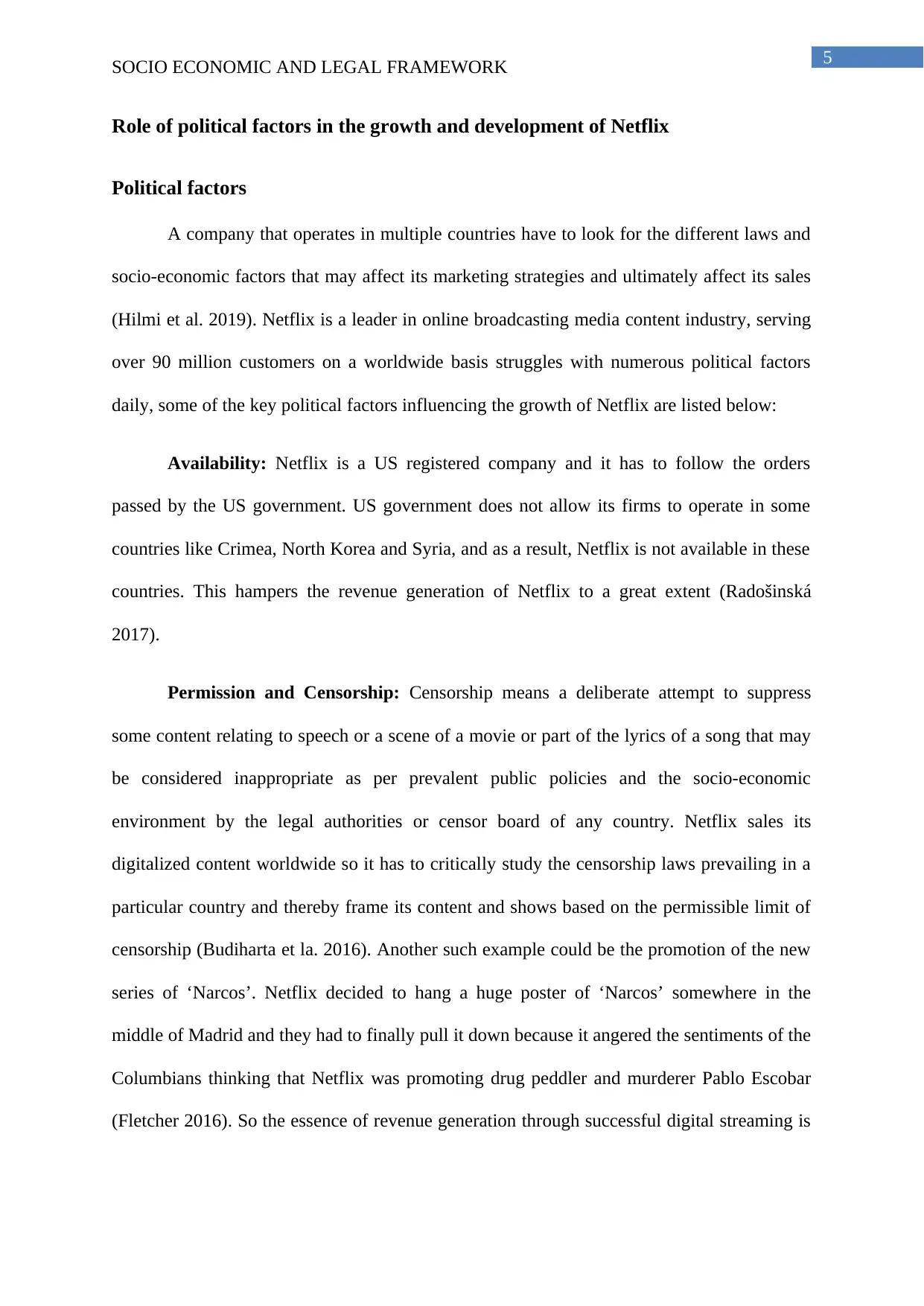
5
SOCIO ECONOMIC AND LEGAL FRAMEWORK
Role of political factors in the growth and development of Netflix
Political factors
A company that operates in multiple countries have to look for the different laws and
socio-economic factors that may affect its marketing strategies and ultimately affect its sales
(Hilmi et al. 2019). Netflix is a leader in online broadcasting media content industry, serving
over 90 million customers on a worldwide basis struggles with numerous political factors
daily, some of the key political factors influencing the growth of Netflix are listed below:
Availability: Netflix is a US registered company and it has to follow the orders
passed by the US government. US government does not allow its firms to operate in some
countries like Crimea, North Korea and Syria, and as a result, Netflix is not available in these
countries. This hampers the revenue generation of Netflix to a great extent (Radošinská
2017).
Permission and Censorship: Censorship means a deliberate attempt to suppress
some content relating to speech or a scene of a movie or part of the lyrics of a song that may
be considered inappropriate as per prevalent public policies and the socio-economic
environment by the legal authorities or censor board of any country. Netflix sales its
digitalized content worldwide so it has to critically study the censorship laws prevailing in a
particular country and thereby frame its content and shows based on the permissible limit of
censorship (Budiharta et la. 2016). Another such example could be the promotion of the new
series of ‘Narcos’. Netflix decided to hang a huge poster of ‘Narcos’ somewhere in the
middle of Madrid and they had to finally pull it down because it angered the sentiments of the
Columbians thinking that Netflix was promoting drug peddler and murderer Pablo Escobar
(Fletcher 2016). So the essence of revenue generation through successful digital streaming is
SOCIO ECONOMIC AND LEGAL FRAMEWORK
Role of political factors in the growth and development of Netflix
Political factors
A company that operates in multiple countries have to look for the different laws and
socio-economic factors that may affect its marketing strategies and ultimately affect its sales
(Hilmi et al. 2019). Netflix is a leader in online broadcasting media content industry, serving
over 90 million customers on a worldwide basis struggles with numerous political factors
daily, some of the key political factors influencing the growth of Netflix are listed below:
Availability: Netflix is a US registered company and it has to follow the orders
passed by the US government. US government does not allow its firms to operate in some
countries like Crimea, North Korea and Syria, and as a result, Netflix is not available in these
countries. This hampers the revenue generation of Netflix to a great extent (Radošinská
2017).
Permission and Censorship: Censorship means a deliberate attempt to suppress
some content relating to speech or a scene of a movie or part of the lyrics of a song that may
be considered inappropriate as per prevalent public policies and the socio-economic
environment by the legal authorities or censor board of any country. Netflix sales its
digitalized content worldwide so it has to critically study the censorship laws prevailing in a
particular country and thereby frame its content and shows based on the permissible limit of
censorship (Budiharta et la. 2016). Another such example could be the promotion of the new
series of ‘Narcos’. Netflix decided to hang a huge poster of ‘Narcos’ somewhere in the
middle of Madrid and they had to finally pull it down because it angered the sentiments of the
Columbians thinking that Netflix was promoting drug peddler and murderer Pablo Escobar
(Fletcher 2016). So the essence of revenue generation through successful digital streaming is
⊘ This is a preview!⊘
Do you want full access?
Subscribe today to unlock all pages.

Trusted by 1+ million students worldwide
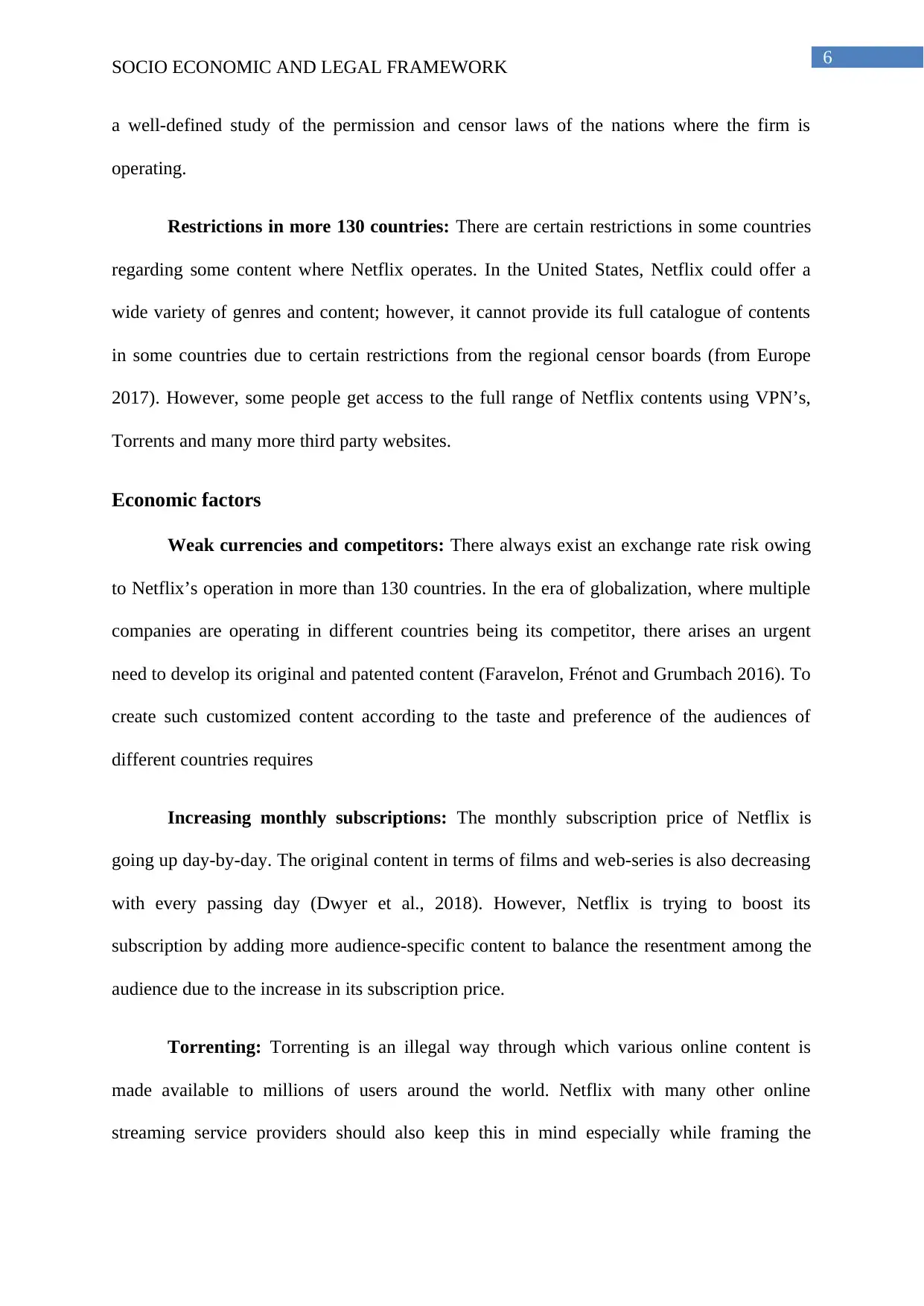
6
SOCIO ECONOMIC AND LEGAL FRAMEWORK
a well-defined study of the permission and censor laws of the nations where the firm is
operating.
Restrictions in more 130 countries: There are certain restrictions in some countries
regarding some content where Netflix operates. In the United States, Netflix could offer a
wide variety of genres and content; however, it cannot provide its full catalogue of contents
in some countries due to certain restrictions from the regional censor boards (from Europe
2017). However, some people get access to the full range of Netflix contents using VPN’s,
Torrents and many more third party websites.
Economic factors
Weak currencies and competitors: There always exist an exchange rate risk owing
to Netflix’s operation in more than 130 countries. In the era of globalization, where multiple
companies are operating in different countries being its competitor, there arises an urgent
need to develop its original and patented content (Faravelon, Frénot and Grumbach 2016). To
create such customized content according to the taste and preference of the audiences of
different countries requires
Increasing monthly subscriptions: The monthly subscription price of Netflix is
going up day-by-day. The original content in terms of films and web-series is also decreasing
with every passing day (Dwyer et al., 2018). However, Netflix is trying to boost its
subscription by adding more audience-specific content to balance the resentment among the
audience due to the increase in its subscription price.
Torrenting: Torrenting is an illegal way through which various online content is
made available to millions of users around the world. Netflix with many other online
streaming service providers should also keep this in mind especially while framing the
SOCIO ECONOMIC AND LEGAL FRAMEWORK
a well-defined study of the permission and censor laws of the nations where the firm is
operating.
Restrictions in more 130 countries: There are certain restrictions in some countries
regarding some content where Netflix operates. In the United States, Netflix could offer a
wide variety of genres and content; however, it cannot provide its full catalogue of contents
in some countries due to certain restrictions from the regional censor boards (from Europe
2017). However, some people get access to the full range of Netflix contents using VPN’s,
Torrents and many more third party websites.
Economic factors
Weak currencies and competitors: There always exist an exchange rate risk owing
to Netflix’s operation in more than 130 countries. In the era of globalization, where multiple
companies are operating in different countries being its competitor, there arises an urgent
need to develop its original and patented content (Faravelon, Frénot and Grumbach 2016). To
create such customized content according to the taste and preference of the audiences of
different countries requires
Increasing monthly subscriptions: The monthly subscription price of Netflix is
going up day-by-day. The original content in terms of films and web-series is also decreasing
with every passing day (Dwyer et al., 2018). However, Netflix is trying to boost its
subscription by adding more audience-specific content to balance the resentment among the
audience due to the increase in its subscription price.
Torrenting: Torrenting is an illegal way through which various online content is
made available to millions of users around the world. Netflix with many other online
streaming service providers should also keep this in mind especially while framing the
Paraphrase This Document
Need a fresh take? Get an instant paraphrase of this document with our AI Paraphraser
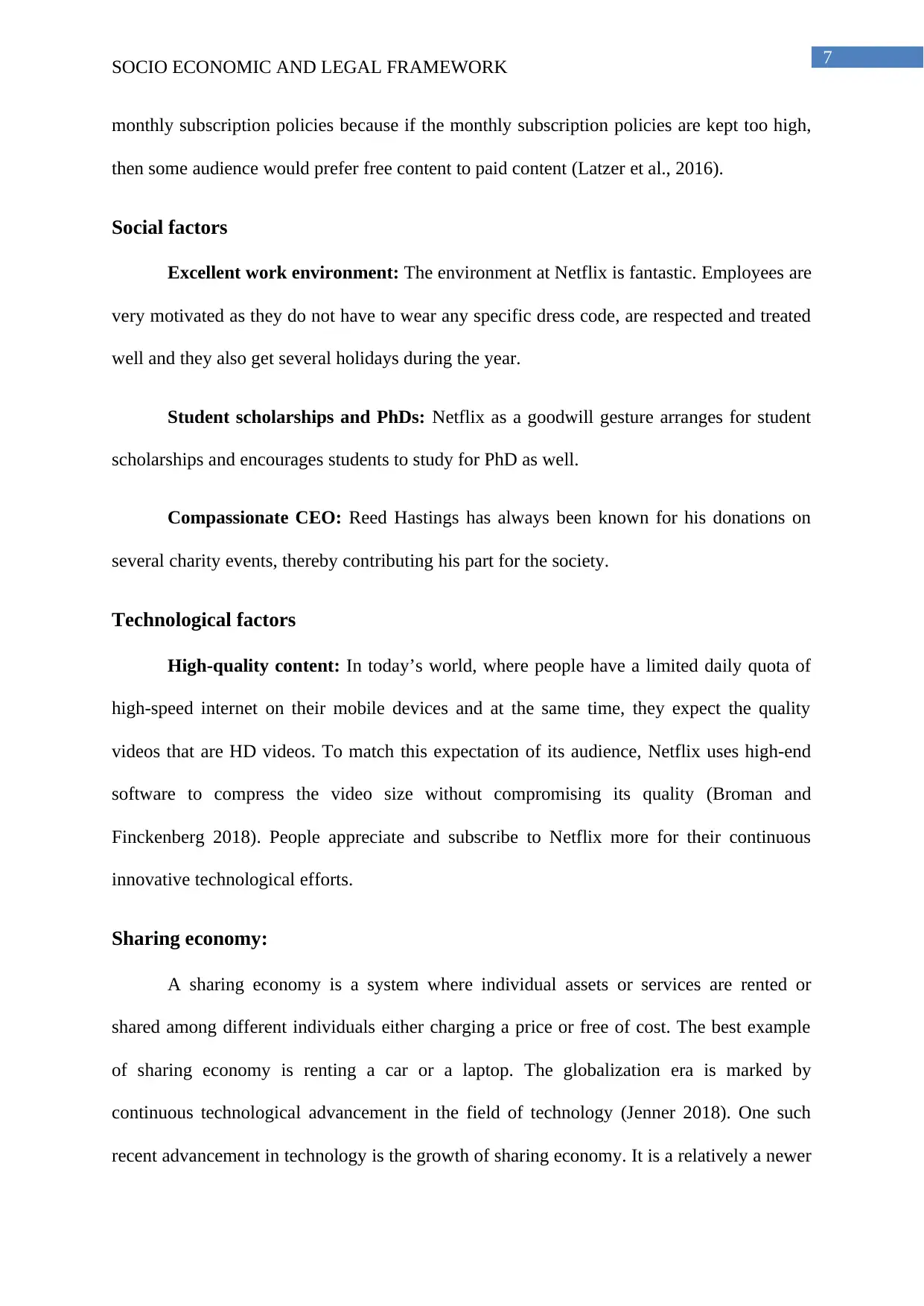
7
SOCIO ECONOMIC AND LEGAL FRAMEWORK
monthly subscription policies because if the monthly subscription policies are kept too high,
then some audience would prefer free content to paid content (Latzer et al., 2016).
Social factors
Excellent work environment: The environment at Netflix is fantastic. Employees are
very motivated as they do not have to wear any specific dress code, are respected and treated
well and they also get several holidays during the year.
Student scholarships and PhDs: Netflix as a goodwill gesture arranges for student
scholarships and encourages students to study for PhD as well.
Compassionate CEO: Reed Hastings has always been known for his donations on
several charity events, thereby contributing his part for the society.
Technological factors
High-quality content: In today’s world, where people have a limited daily quota of
high-speed internet on their mobile devices and at the same time, they expect the quality
videos that are HD videos. To match this expectation of its audience, Netflix uses high-end
software to compress the video size without compromising its quality (Broman and
Finckenberg 2018). People appreciate and subscribe to Netflix more for their continuous
innovative technological efforts.
Sharing economy:
A sharing economy is a system where individual assets or services are rented or
shared among different individuals either charging a price or free of cost. The best example
of sharing economy is renting a car or a laptop. The globalization era is marked by
continuous technological advancement in the field of technology (Jenner 2018). One such
recent advancement in technology is the growth of sharing economy. It is a relatively a newer
SOCIO ECONOMIC AND LEGAL FRAMEWORK
monthly subscription policies because if the monthly subscription policies are kept too high,
then some audience would prefer free content to paid content (Latzer et al., 2016).
Social factors
Excellent work environment: The environment at Netflix is fantastic. Employees are
very motivated as they do not have to wear any specific dress code, are respected and treated
well and they also get several holidays during the year.
Student scholarships and PhDs: Netflix as a goodwill gesture arranges for student
scholarships and encourages students to study for PhD as well.
Compassionate CEO: Reed Hastings has always been known for his donations on
several charity events, thereby contributing his part for the society.
Technological factors
High-quality content: In today’s world, where people have a limited daily quota of
high-speed internet on their mobile devices and at the same time, they expect the quality
videos that are HD videos. To match this expectation of its audience, Netflix uses high-end
software to compress the video size without compromising its quality (Broman and
Finckenberg 2018). People appreciate and subscribe to Netflix more for their continuous
innovative technological efforts.
Sharing economy:
A sharing economy is a system where individual assets or services are rented or
shared among different individuals either charging a price or free of cost. The best example
of sharing economy is renting a car or a laptop. The globalization era is marked by
continuous technological advancement in the field of technology (Jenner 2018). One such
recent advancement in technology is the growth of sharing economy. It is a relatively a newer
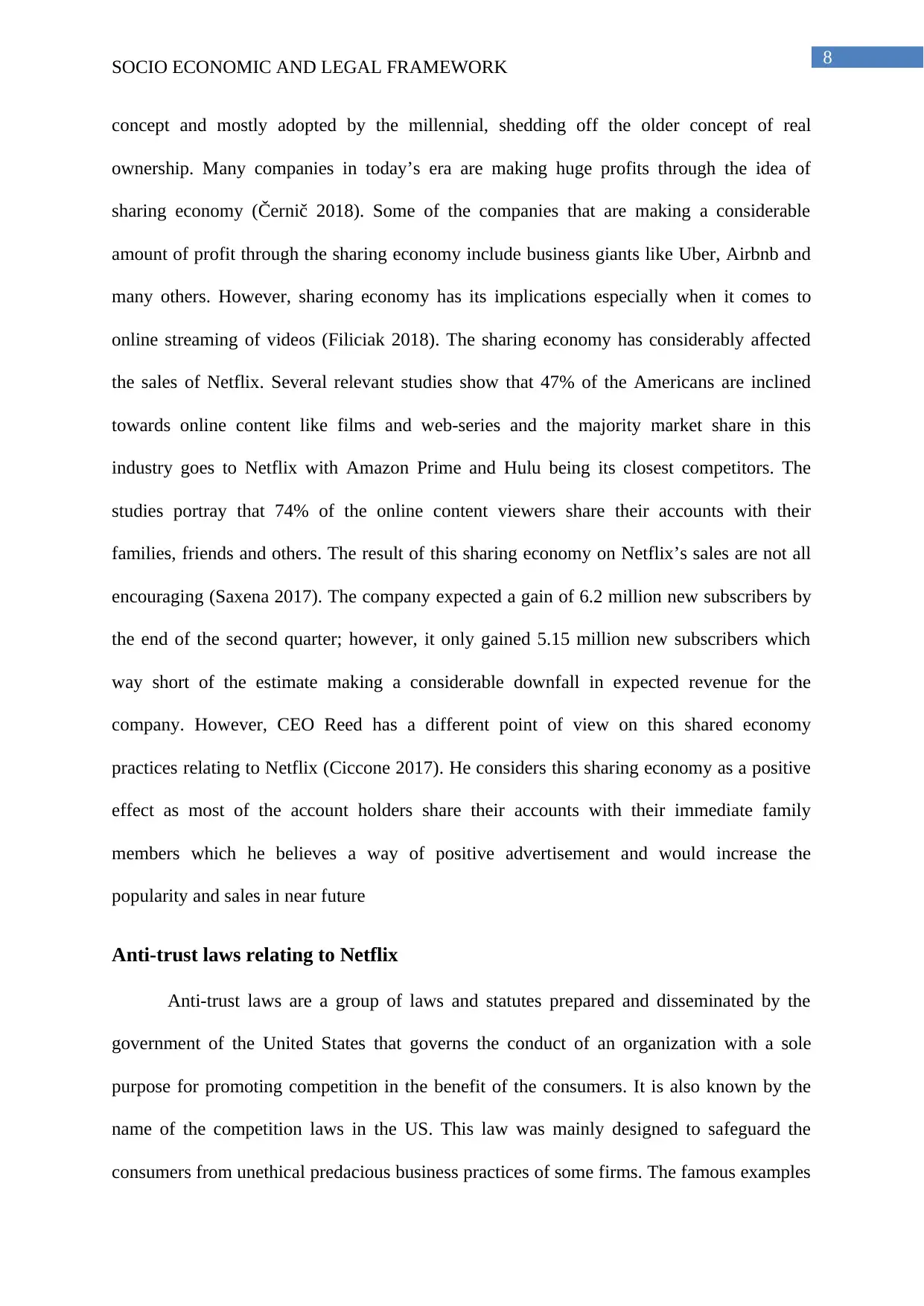
8
SOCIO ECONOMIC AND LEGAL FRAMEWORK
concept and mostly adopted by the millennial, shedding off the older concept of real
ownership. Many companies in today’s era are making huge profits through the idea of
sharing economy (Černič 2018). Some of the companies that are making a considerable
amount of profit through the sharing economy include business giants like Uber, Airbnb and
many others. However, sharing economy has its implications especially when it comes to
online streaming of videos (Filiciak 2018). The sharing economy has considerably affected
the sales of Netflix. Several relevant studies show that 47% of the Americans are inclined
towards online content like films and web-series and the majority market share in this
industry goes to Netflix with Amazon Prime and Hulu being its closest competitors. The
studies portray that 74% of the online content viewers share their accounts with their
families, friends and others. The result of this sharing economy on Netflix’s sales are not all
encouraging (Saxena 2017). The company expected a gain of 6.2 million new subscribers by
the end of the second quarter; however, it only gained 5.15 million new subscribers which
way short of the estimate making a considerable downfall in expected revenue for the
company. However, CEO Reed has a different point of view on this shared economy
practices relating to Netflix (Ciccone 2017). He considers this sharing economy as a positive
effect as most of the account holders share their accounts with their immediate family
members which he believes a way of positive advertisement and would increase the
popularity and sales in near future
Anti-trust laws relating to Netflix
Anti-trust laws are a group of laws and statutes prepared and disseminated by the
government of the United States that governs the conduct of an organization with a sole
purpose for promoting competition in the benefit of the consumers. It is also known by the
name of the competition laws in the US. This law was mainly designed to safeguard the
consumers from unethical predacious business practices of some firms. The famous examples
SOCIO ECONOMIC AND LEGAL FRAMEWORK
concept and mostly adopted by the millennial, shedding off the older concept of real
ownership. Many companies in today’s era are making huge profits through the idea of
sharing economy (Černič 2018). Some of the companies that are making a considerable
amount of profit through the sharing economy include business giants like Uber, Airbnb and
many others. However, sharing economy has its implications especially when it comes to
online streaming of videos (Filiciak 2018). The sharing economy has considerably affected
the sales of Netflix. Several relevant studies show that 47% of the Americans are inclined
towards online content like films and web-series and the majority market share in this
industry goes to Netflix with Amazon Prime and Hulu being its closest competitors. The
studies portray that 74% of the online content viewers share their accounts with their
families, friends and others. The result of this sharing economy on Netflix’s sales are not all
encouraging (Saxena 2017). The company expected a gain of 6.2 million new subscribers by
the end of the second quarter; however, it only gained 5.15 million new subscribers which
way short of the estimate making a considerable downfall in expected revenue for the
company. However, CEO Reed has a different point of view on this shared economy
practices relating to Netflix (Ciccone 2017). He considers this sharing economy as a positive
effect as most of the account holders share their accounts with their immediate family
members which he believes a way of positive advertisement and would increase the
popularity and sales in near future
Anti-trust laws relating to Netflix
Anti-trust laws are a group of laws and statutes prepared and disseminated by the
government of the United States that governs the conduct of an organization with a sole
purpose for promoting competition in the benefit of the consumers. It is also known by the
name of the competition laws in the US. This law was mainly designed to safeguard the
consumers from unethical predacious business practices of some firms. The famous examples
⊘ This is a preview!⊘
Do you want full access?
Subscribe today to unlock all pages.

Trusted by 1+ million students worldwide
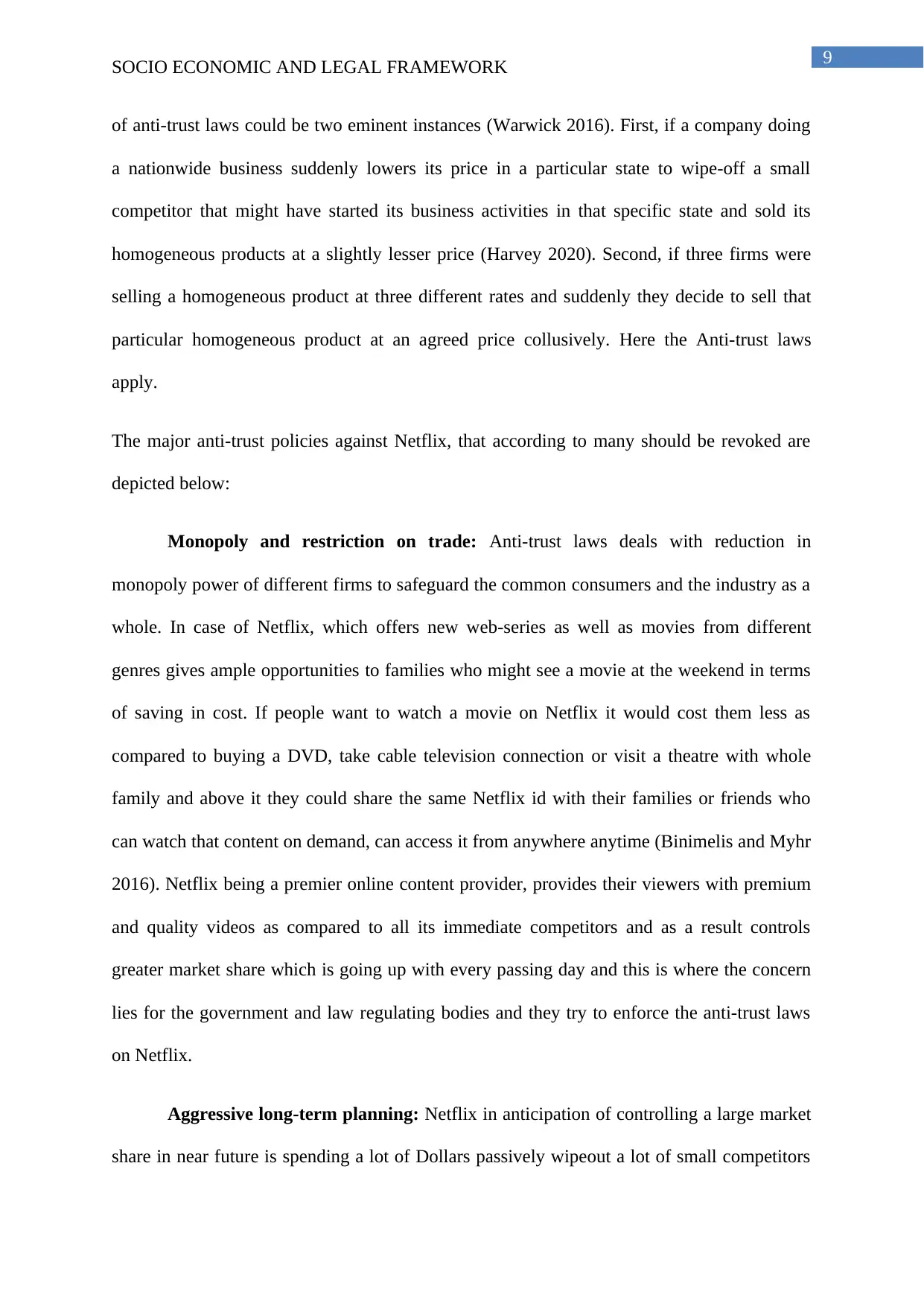
9
SOCIO ECONOMIC AND LEGAL FRAMEWORK
of anti-trust laws could be two eminent instances (Warwick 2016). First, if a company doing
a nationwide business suddenly lowers its price in a particular state to wipe-off a small
competitor that might have started its business activities in that specific state and sold its
homogeneous products at a slightly lesser price (Harvey 2020). Second, if three firms were
selling a homogeneous product at three different rates and suddenly they decide to sell that
particular homogeneous product at an agreed price collusively. Here the Anti-trust laws
apply.
The major anti-trust policies against Netflix, that according to many should be revoked are
depicted below:
Monopoly and restriction on trade: Anti-trust laws deals with reduction in
monopoly power of different firms to safeguard the common consumers and the industry as a
whole. In case of Netflix, which offers new web-series as well as movies from different
genres gives ample opportunities to families who might see a movie at the weekend in terms
of saving in cost. If people want to watch a movie on Netflix it would cost them less as
compared to buying a DVD, take cable television connection or visit a theatre with whole
family and above it they could share the same Netflix id with their families or friends who
can watch that content on demand, can access it from anywhere anytime (Binimelis and Myhr
2016). Netflix being a premier online content provider, provides their viewers with premium
and quality videos as compared to all its immediate competitors and as a result controls
greater market share which is going up with every passing day and this is where the concern
lies for the government and law regulating bodies and they try to enforce the anti-trust laws
on Netflix.
Aggressive long-term planning: Netflix in anticipation of controlling a large market
share in near future is spending a lot of Dollars passively wipeout a lot of small competitors
SOCIO ECONOMIC AND LEGAL FRAMEWORK
of anti-trust laws could be two eminent instances (Warwick 2016). First, if a company doing
a nationwide business suddenly lowers its price in a particular state to wipe-off a small
competitor that might have started its business activities in that specific state and sold its
homogeneous products at a slightly lesser price (Harvey 2020). Second, if three firms were
selling a homogeneous product at three different rates and suddenly they decide to sell that
particular homogeneous product at an agreed price collusively. Here the Anti-trust laws
apply.
The major anti-trust policies against Netflix, that according to many should be revoked are
depicted below:
Monopoly and restriction on trade: Anti-trust laws deals with reduction in
monopoly power of different firms to safeguard the common consumers and the industry as a
whole. In case of Netflix, which offers new web-series as well as movies from different
genres gives ample opportunities to families who might see a movie at the weekend in terms
of saving in cost. If people want to watch a movie on Netflix it would cost them less as
compared to buying a DVD, take cable television connection or visit a theatre with whole
family and above it they could share the same Netflix id with their families or friends who
can watch that content on demand, can access it from anywhere anytime (Binimelis and Myhr
2016). Netflix being a premier online content provider, provides their viewers with premium
and quality videos as compared to all its immediate competitors and as a result controls
greater market share which is going up with every passing day and this is where the concern
lies for the government and law regulating bodies and they try to enforce the anti-trust laws
on Netflix.
Aggressive long-term planning: Netflix in anticipation of controlling a large market
share in near future is spending a lot of Dollars passively wipeout a lot of small competitors
Paraphrase This Document
Need a fresh take? Get an instant paraphrase of this document with our AI Paraphraser
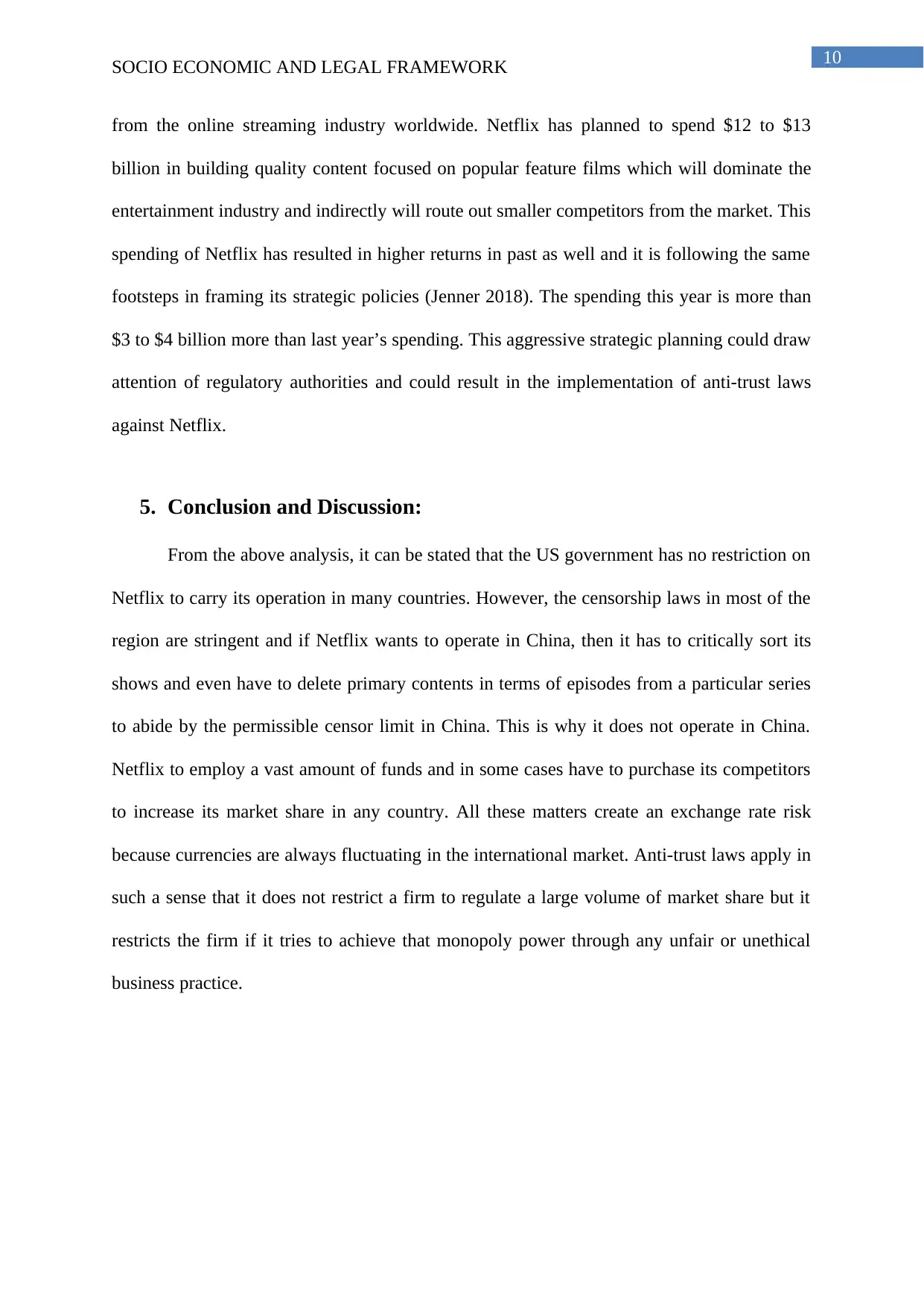
10
SOCIO ECONOMIC AND LEGAL FRAMEWORK
from the online streaming industry worldwide. Netflix has planned to spend $12 to $13
billion in building quality content focused on popular feature films which will dominate the
entertainment industry and indirectly will route out smaller competitors from the market. This
spending of Netflix has resulted in higher returns in past as well and it is following the same
footsteps in framing its strategic policies (Jenner 2018). The spending this year is more than
$3 to $4 billion more than last year’s spending. This aggressive strategic planning could draw
attention of regulatory authorities and could result in the implementation of anti-trust laws
against Netflix.
5. Conclusion and Discussion:
From the above analysis, it can be stated that the US government has no restriction on
Netflix to carry its operation in many countries. However, the censorship laws in most of the
region are stringent and if Netflix wants to operate in China, then it has to critically sort its
shows and even have to delete primary contents in terms of episodes from a particular series
to abide by the permissible censor limit in China. This is why it does not operate in China.
Netflix to employ a vast amount of funds and in some cases have to purchase its competitors
to increase its market share in any country. All these matters create an exchange rate risk
because currencies are always fluctuating in the international market. Anti-trust laws apply in
such a sense that it does not restrict a firm to regulate a large volume of market share but it
restricts the firm if it tries to achieve that monopoly power through any unfair or unethical
business practice.
SOCIO ECONOMIC AND LEGAL FRAMEWORK
from the online streaming industry worldwide. Netflix has planned to spend $12 to $13
billion in building quality content focused on popular feature films which will dominate the
entertainment industry and indirectly will route out smaller competitors from the market. This
spending of Netflix has resulted in higher returns in past as well and it is following the same
footsteps in framing its strategic policies (Jenner 2018). The spending this year is more than
$3 to $4 billion more than last year’s spending. This aggressive strategic planning could draw
attention of regulatory authorities and could result in the implementation of anti-trust laws
against Netflix.
5. Conclusion and Discussion:
From the above analysis, it can be stated that the US government has no restriction on
Netflix to carry its operation in many countries. However, the censorship laws in most of the
region are stringent and if Netflix wants to operate in China, then it has to critically sort its
shows and even have to delete primary contents in terms of episodes from a particular series
to abide by the permissible censor limit in China. This is why it does not operate in China.
Netflix to employ a vast amount of funds and in some cases have to purchase its competitors
to increase its market share in any country. All these matters create an exchange rate risk
because currencies are always fluctuating in the international market. Anti-trust laws apply in
such a sense that it does not restrict a firm to regulate a large volume of market share but it
restricts the firm if it tries to achieve that monopoly power through any unfair or unethical
business practice.
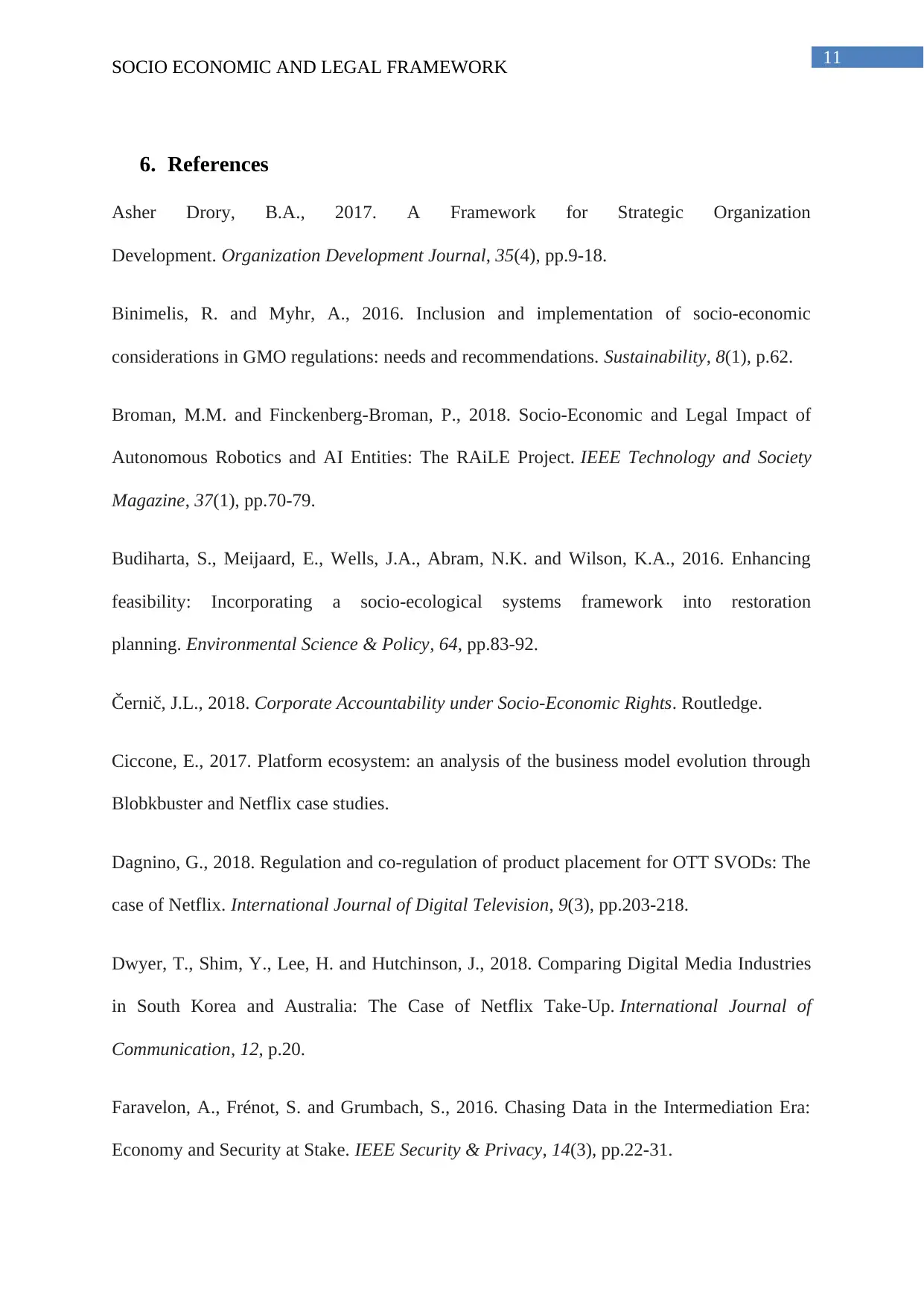
11
SOCIO ECONOMIC AND LEGAL FRAMEWORK
6. References
Asher Drory, B.A., 2017. A Framework for Strategic Organization
Development. Organization Development Journal, 35(4), pp.9-18.
Binimelis, R. and Myhr, A., 2016. Inclusion and implementation of socio-economic
considerations in GMO regulations: needs and recommendations. Sustainability, 8(1), p.62.
Broman, M.M. and Finckenberg-Broman, P., 2018. Socio-Economic and Legal Impact of
Autonomous Robotics and AI Entities: The RAiLE Project. IEEE Technology and Society
Magazine, 37(1), pp.70-79.
Budiharta, S., Meijaard, E., Wells, J.A., Abram, N.K. and Wilson, K.A., 2016. Enhancing
feasibility: Incorporating a socio-ecological systems framework into restoration
planning. Environmental Science & Policy, 64, pp.83-92.
Černič, J.L., 2018. Corporate Accountability under Socio-Economic Rights. Routledge.
Ciccone, E., 2017. Platform ecosystem: an analysis of the business model evolution through
Blobkbuster and Netflix case studies.
Dagnino, G., 2018. Regulation and co-regulation of product placement for OTT SVODs: The
case of Netflix. International Journal of Digital Television, 9(3), pp.203-218.
Dwyer, T., Shim, Y., Lee, H. and Hutchinson, J., 2018. Comparing Digital Media Industries
in South Korea and Australia: The Case of Netflix Take-Up. International Journal of
Communication, 12, p.20.
Faravelon, A., Frénot, S. and Grumbach, S., 2016. Chasing Data in the Intermediation Era:
Economy and Security at Stake. IEEE Security & Privacy, 14(3), pp.22-31.
SOCIO ECONOMIC AND LEGAL FRAMEWORK
6. References
Asher Drory, B.A., 2017. A Framework for Strategic Organization
Development. Organization Development Journal, 35(4), pp.9-18.
Binimelis, R. and Myhr, A., 2016. Inclusion and implementation of socio-economic
considerations in GMO regulations: needs and recommendations. Sustainability, 8(1), p.62.
Broman, M.M. and Finckenberg-Broman, P., 2018. Socio-Economic and Legal Impact of
Autonomous Robotics and AI Entities: The RAiLE Project. IEEE Technology and Society
Magazine, 37(1), pp.70-79.
Budiharta, S., Meijaard, E., Wells, J.A., Abram, N.K. and Wilson, K.A., 2016. Enhancing
feasibility: Incorporating a socio-ecological systems framework into restoration
planning. Environmental Science & Policy, 64, pp.83-92.
Černič, J.L., 2018. Corporate Accountability under Socio-Economic Rights. Routledge.
Ciccone, E., 2017. Platform ecosystem: an analysis of the business model evolution through
Blobkbuster and Netflix case studies.
Dagnino, G., 2018. Regulation and co-regulation of product placement for OTT SVODs: The
case of Netflix. International Journal of Digital Television, 9(3), pp.203-218.
Dwyer, T., Shim, Y., Lee, H. and Hutchinson, J., 2018. Comparing Digital Media Industries
in South Korea and Australia: The Case of Netflix Take-Up. International Journal of
Communication, 12, p.20.
Faravelon, A., Frénot, S. and Grumbach, S., 2016. Chasing Data in the Intermediation Era:
Economy and Security at Stake. IEEE Security & Privacy, 14(3), pp.22-31.
⊘ This is a preview!⊘
Do you want full access?
Subscribe today to unlock all pages.

Trusted by 1+ million students worldwide
1 out of 14
Related Documents
Your All-in-One AI-Powered Toolkit for Academic Success.
+13062052269
info@desklib.com
Available 24*7 on WhatsApp / Email
![[object Object]](/_next/static/media/star-bottom.7253800d.svg)
Unlock your academic potential
Copyright © 2020–2025 A2Z Services. All Rights Reserved. Developed and managed by ZUCOL.





